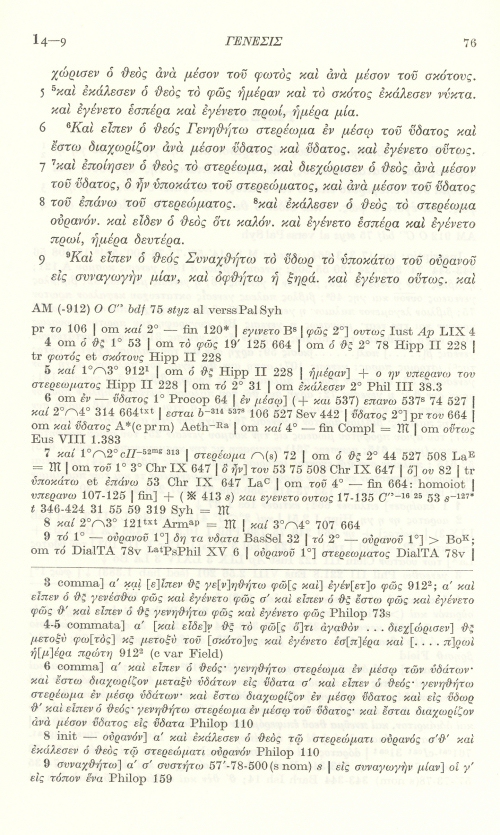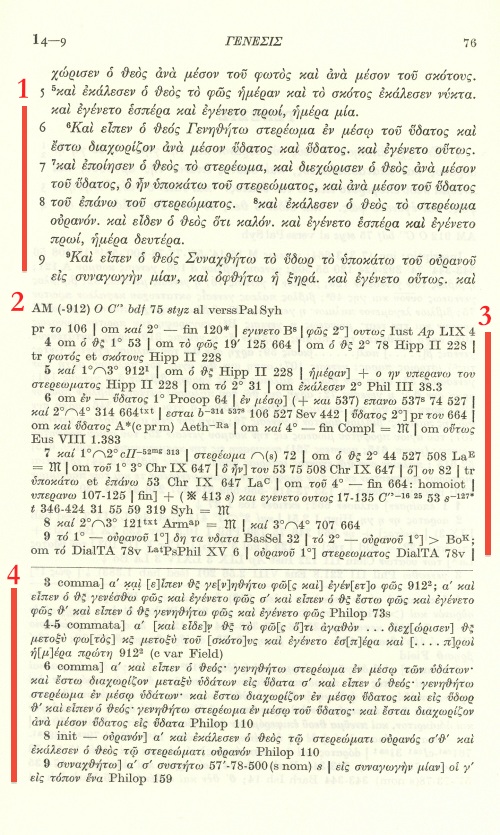The one who is serious about getting at the earliest attainable text of the Hebrew Bible will eventually find herself or himself face-to-face with a page like this:

The Göttingen Septuagint is the largest scholarly edition of the Greek translation of the Hebrew Bible. Its full title is Septuaginta: Vetus Testamentum Graecum Auctoritate Academiae Scientiarum Gottingensis editum. Vandenhoeck & Ruprecht in Göttingen,

Germany publishes the series, which includes more than 20 volumes covering some 40 biblical books (counting the minor prophets as 12). Various editors are working toward the publication of additional volumes.
But if good coffee, fine wine, or well-aged cheese requires work on the part of the one taking it in, the Göttingen LXX makes its own demands of the reader who would use it. The critical apparatuses on each page have Greek, abbreviated Greek, abbreviated Latin, and other potentially unfamiliar sigla. The introductions in each volume are in German.
How to read and understand the Göttingen Septuagint, then? To begin, here is the sample page from above:

There are four main parts to the page, marked in the image above by the numbers 1 through 4.
- The reconstructed Greek critical text (“Der kritische Text”)
- The Source List (“Kopfleiste”) (note: not every Göttingen volume has this)
- The First Critical Apparatus (“Apparat I”)
- The Second Critical Apparatus (“Apparat II”)
In part 1 of my primer, I covered numbers 1 and 2 above. To summarize a bit:
1. With verse references in both the margin and in the body of the text, the top portion of each page of the Göttingen Septuagint is the editorially reconstructed text of each biblical book.
2. The Kopfleiste comes just below the text and above the apparatuses. Wevers notes it as a list of all manuscripts and versions used, listed in the order that they appear in the apparatus on that page. A fragmentary textual witness is enclosed in parenthesis.
Next are the two critical apparatuses. In his introduction to Genesis (conveniently translated into English here, from which I quote), editor John William Wevers speaks of the critically reconstructed text as an “approximation of the original” and “hopefully the best which could be reconstructed.” I previously noted:
[Göttingen] editors have viewed and listed the readings of many manuscripts and versions. The critical apparatuses are where they list those readings, so the user of Göttingen can see other readings as they compare with the critically reconstructed text. (Because the Göttingen editions are critical/eclectic texts, no single manuscript will match the text of the Göttingen Septuagint.)
The International Organization for Septuagint and Cognate Studies (IOSCS) notes (from here):
The Göttingen Septuagint features two apparatuses (as does the Larger Cambridge Septuagint), the first for LXX/OG textual evidence proper and the second for so-called hexaplaric evidence, i.e. “rival” translations/revisions of the translated LXX/OG (such as circulated under the labels “Theodotion,” “Aquila,” and “Symmachus”), preserved largely through the influence of Origen’s Hexapla. For LXX/OG research the importance of both apparatuses is second only to the critical text itself.
The challenge, of course, is that to make sense of the apparatuses and their abbreviations.
3. The First Critical Apparatus (“Apparat I”)
The “textual evidence proper” consists of any readings that the editor deems as variant to the reconstructed text. The editors follow a consistent order in the witnesses they cite. (There is minor variation, volume to volume.) In Genesis Wevers writes:
The witnesses for a variant are always arranged in a set order: a) the uncial texts in alphabetic order; b) the papyri in numerical order; c) the witnesses of the O‘ mss [AKJ: the “hexaplaric group”]; d) the witnesses of the C‘’ mss [AKJ: the “Catena group”]; e) the remaining text families (comp Section B I above) in alphabetical order; f) the rest of the Greek evidence in the following order: N.T. witnesses, Ios [AKJ: Josephus], Phil [AKJ: Philo], followed by the rest of the Greek writers in alphabetic order; g) La (or the sub-groups, for ex. LaI Las, etc.) [AKJ: Old Latin versions], followed by the other versions in alphabetic order; h) citations of the Latin Fathers, introduced by the sign Lat (these witnesses always stand in opposition to La or a sub-group of La); i) other witnesses or commentaries.
To look at an example of the first critical apparatus, Deuteronomy 6:5 in the Göttingen edition reads:
καὶ ἀγαπήσεις κύριον τὸν θεόν σου ἐξ ὅλης τῆς διανοίας σου καὶ ἐξ ὅλης τῆς ψυχῆς σου καὶ ἐξ ὅλης τῆς δυνάμεώς σου.
(And you shall love the Lord your God with all your mind and with all your soul and with all your strength.)
The apparatus for that verse, in part, has:
om καί 1° Arab Sa17 | αγαπησης 30; αγαπη σε 527 | κύριον τόν] bis scr 120* | om σου 1° Tht Dtap | ἐξ 1°—διανοίας] εν ολη τη καρδια Matth 22:37 |
With each unit broken up by line here, the apparatus gives this information about its manuscripts:
- Arab and Sa17 omit (om) the first (1°) use of καί
- 30 has αγαπησης; 527 has αγαπη σε
- 120* has κύριον τόν written (scr) twice (bis)
- Tht Dtap omits (om) the first (1°) use of σου
- From the first use (1°) of ἐξ through (—) the word διανοίας, Matthew 22:37 has rather (]) εν ολη τη καρδια
One has to go to the introduction for information about the manuscripts “Arab” (Arabic version), ” Sa17” (from the Sahidic version), “30” and “527” (minuscule manuscripts), “120*” (also a minuscule manuscript, where the asterisk * refers to “the original reading of a ms,” as opposed to a “correction”), and “Tht Dtap” (Tht=Theodoretus (“Cyrensis=Cyrrhensis”); Dt=his Quaestiones in Deuteronomium; ap refers, Wevers notes, “to readings (variants) in the apparatus of editions”).
Miles Van Pelt has produced a concise two-page summary of sigla and abbreviations. I offer appreciation and gratitude to Miles that I can link to that pdf here. That offers further instruction as to deciphering the apparatuses (both the first and second) in the Göttingen volumes. The introductions to given volumes contain the signs/symbols and abbreviations (“Zeichen und Abkürzungen”), as well.
Boromir had it right:
So I’ll write about the Second Critical Apparatus (“Apparat II”) in a future post. Until then….



Boromir?! I might have expected Gandalf or perhaps Aragorn (or even one of the elven lords), but Boromir? He was not much interested in such matters, only power. But you made your point! 🙂
Ah, yes, indeed. Perhaps he would not have tarried long with Göttingen.
Actually, Rod, my first meme was “Good Guy Greg” (for the alliteration with Göttingen–Good Guy Greg Grasps Göttingen), but I didn’t think the cigarette in the mouth was quite the way I wanted to go with this post. 🙂
Reblogged this on Streaming Along the Negeb and commented:
Part 2
bless you and Miles van Pelt for making these incredibly helpful resources available!
Sure thing! Glad it is useful to you.
THANK YOU! This is fantastic.
Part 3 on the way?
Oh, I wish! It’s been indefinitely delayed. Partly because it’s what I think is the hardest part of the whole setup… but largely due to time limitations. I do hope to finish it some day, though!
Glad you found this helpful! If you don’t mind my asking, what is the setting you used it for?
Dear Abram,
Thank you! These blog posts are the only advice of its kind online!
Can I ask:
An interesting variant in 2 Kgs 2:12 (4 Reigns) shows “x e uv y” in the apparatus.
A different critical edition reads “euvxy”.
What is this notation?! I would think these identify manuscripts, but that doesn’t match the scheme which manuscripts have a numerical ID. Any ideas?
Hi, Zach! I’ve not been using the Göttingen LXX lately, so I’m afraid I can’t help here this time–hopefully you’ll be able to track something down, though. You might try the “Nerdy Language Majors” group on Facebook, if you haven’t already.
Thank you Abram for the quick reply. I will ask my local superhero librarian.
BTW I enjoy your blog. I plan to check frequently.
Thanks! Sounds good.
Abram,
OK so this was the “big” Cambridge edition (Brooke, McLean, Thackeray). I was pleasantly surprised to find that euvxy denotes 5 minuscules. I have only begun to look into the dates, but it looks like one might be ninth century.